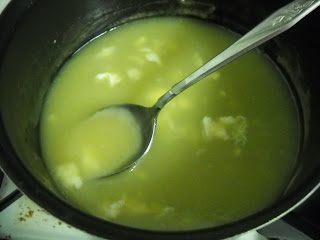For my next mash-up, I had to figure out a way to use up leftover ricotta, sour cream, huckleberry jam and "never-fail" pie crust a la Marcia Adams' Heartland cookbook. Since I didn't have enough pie dough or huckleberry jam to make an actual pie I settled for several smaller tarts. And then I added bacon.
The mashup recipe: Huckleberry-Bacon Cheese Tarts with Nutella Powder
With other mashup recipes, I may look up similar recipes to figure out logistical things: how long to fry the lumpia, how to wrap the maki roll. This time, I more or less followed another recipe - not for tarts but for cheesecake. The recipe comes from Sorrento Cheese's Ricotta Cheese Dessert Recipes (available in a fully searchable PDF). Scroll down to page 4 and you will see the recipe for "New York Style Cheesecake with Strawberries". How to use this recipe to make tarts? I followed the cheesecake portion of the recipe, with some modifications - adding an ingredient here or there, but specifically cutting down the quantities by about a third.
Makes 6 to 8 tarts
Ingredients (state flag indicates State-by-State post where ingredient was featured. Ingredients with no flag were not specifically used for any one post):
Tarts: leftover pie crust dough (enough for 6 to 8 tarts)
leftover pie crust dough (enough for 6 to 8 tarts) 3 pieces bacon, cooked to crispy
3 pieces bacon, cooked to crispy 2 to 3 tablespoons huckleberry jam (or blueberry jam if you must, due to the limited availability of huckleberry jam outside the Northwest)
2 to 3 tablespoons huckleberry jam (or blueberry jam if you must, due to the limited availability of huckleberry jam outside the Northwest) 5 ounces ricotta cheese
5 ounces ricotta cheese 1/4 cup sour cream
1/4 cup sour cream whipping cream (whipped, for topping)
whipping cream (whipped, for topping)
1/4 cup soft cream cheese
1/2 cup sugar, plus extra for sweetening the whipping cream
dash vanilla
flour (for rolling out the dough)
1 egg
1 teaspoon lemon zest
juice of lemon
dash salt
Nutella Powder Topping: 25 grams tapioca maltodextrin (measured out on digital scale)
25 grams tapioca maltodextrin (measured out on digital scale)
75 grams nutella (measured out on digital scale)
You will also need 6 to 8 small tart tins (I got mine for 60 cents each at the Bed Bath and Beyond), and oil for the insides of the tarts
First, roll out the pie dough. I was using dough left over from the sugar cream pie I made from Marcia Adams' Heartland cookbook. I had just enough dough for six tarts, so that's how many I made. Oil up the sides of the tart tins and lay the dough in them. If and when they break, just patch them up with little pieces of dough. Poke the bottoms and sides several times with a fork.
For the cheese tart filling, measure out your ricotta (I had the digital scale, so I might as well have used it).
Assemble your tarts thusly:

First add some of the cheese filling - it will be somewhat thin.

Next, drop a small dollop of huckleberry jam in the center of each tart

And then sprinkle bacon pieces atop each tart.

Bake in the oven for 15 to 20 minutes at 350 degrees, and let cool.
You could just eat them like this, but you don't want to do that, do you? I chose to flex my nascent molecular gastronomy muscles yet again, hoping to get something more powder-like than the olive oil powder that I had made a while back. By following the video that Will Goldfarb filmed for Gourmet magazine on how to make nutella powder - and yes, this is more or less his recipe and procedure, so credit where it is due - I actually did this time.
For the nutella powder (or "soil" as Goldfarb calls it), measure out your nutella and tapioca maltodextrin exactly.

I was surprised at how much smaller 75 grams of nutella were...

...than 25 grams of tapioca maltodextrin.
Here's where I made my mistake before, I think. I used a hand whisk, which was correct, but whisked the olive oil and tapioca maltodextrin very quickly. What Goldfarb does is whisk it sloooooowly.

Yes, it still clumped inside the whisk at first, but it did so in the video, so I decided to be patient this time and keep at it.

In just a few short minutes, the clump broke itself down, and I got a wet sand sort of powder. Patience - not one of my virtues - paid off this time.

If you want whipped cream as an additional garnish, whip it up and sweeten it, and put it on the side, or top the tart first with the whipped cream and then the nutella powder.
The tarts were not terribly sweet, which was a nice way to let the sweetness of the huckleberry and the nutella come out. I don't know if cooks in the Northwest combine bacon and huckleberry very often, but in this recipe they went together very well. I imagine the same could be said for the closely-related blueberry, but that's for me to try another time.










































